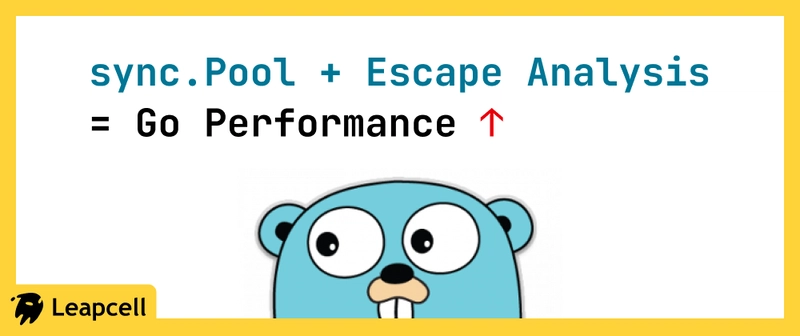Usage Scenarios of sync.Pool
sync.Pool is a high-performance tool in Go's standard library for caching and reusing temporary objects. It is suitable for the following scenarios:
Frequent Temporary Object Allocation
Scenario: Objects that need to be frequently created and destroyed (such as buffers, parsers, temporary structs).
Optimization goal: Reduce memory allocations and garbage collection (GC) pressure.
Example:
// Reuse byte buffers
var bufPool = sync.Pool{
New: func() interface{} {
return bytes.NewBuffer(make([]byte, 0, 1024))
},
}
func GetBuffer() *bytes.Buffer {
return bufPool.Get().(*bytes.Buffer)
}
func PutBuffer(buf *bytes.Buffer) {
buf.Reset()
bufPool.Put(buf)
}
High-Concurrency Scenarios
Scenario: Concurrent request processing (such as HTTP services, database connection pools).
Optimization goal: Avoid contention for global resources, and improve performance through local caching.
Example:
// Reuse JSON decoders in HTTP request processing
var decoderPool = sync.Pool{
New: func() interface{} {
return json.NewDecoder(nil)
},
}
func HandleRequest(r io.Reader) {
decoder := decoderPool.Get().(*json.Decoder)
decoder.Reset(r)
defer decoderPool.Put(decoder)
// Use decoder to parse data
}
Short-Lived Objects
Scenario: Objects that are only used in a single operation and can be reused immediately after completion.
Optimization goal: Avoid repeated initialization (such as temporary handles for database queries).
Example:
// Reuse temporary structs for database queries
type QueryParams struct {
Table string
Filter map[string]interface{}
}
var queryPool = sync.Pool{
New: func() interface{} {
return &QueryParams{Filter: make(map[string]interface{})}
},
}
func NewQuery() *QueryParams {
q := queryPool.Get().(*QueryParams)
q.Table = "" // Reset fields
clear(q.Filter)
return q
}
func ReleaseQuery(q *QueryParams) {
queryPool.Put(q)
}
Reducing Heap Allocation via Escape Analysis
Escape Analysis is a mechanism in the Go compiler that determines at compile time whether variables escape to the heap. The following methods can reduce heap allocation:
Avoid Pointer Escape
Principle: Try to allocate variables on the stack.
Optimization methods:
- Avoid returning pointers to local variables: If a pointer is not referenced after the function returns, the compiler may keep it on the stack.
Example:
// Incorrect: Returning a pointer to a local variable triggers escape
func Bad() *int {
x := 42
return &x // x escapes to the heap
}
// Correct: Pass through parameters to avoid escape
func Good(x *int) {
*x = 42
}
Control Variable Scope
Principle: Narrow the lifetime of variables to reduce the chance of escape.
Optimization methods:
- Complete operations within local scope: Avoid passing local variables to the outside (such as to global variables or closures).
Example:
func Process(data []byte) {
// Local variable processing, does not escape
var result struct {
A int
B string
}
json.Unmarshal(data, &result)
// Operate on result
}
Optimize Data Structures
Principle: Avoid complex data structures that cause escape.
Optimization methods:
- Pre-allocate slices/maps: Specify capacity to avoid heap allocation when expanding.
Example:
func NoEscape() {
// Allocated on the stack (capacity is known)
buf := make([]byte, 0, 1024)
// Operate on buf
}
func Escape() {
// May escape (capacity changes dynamically)
buf := make([]byte, 0)
// Operate on buf
}
Compiler Directive Assistance
Principle: Guide the compiler’s optimization through comments (use with caution).
Optimization methods:
-
//go:noinline: Prohibits function inlining, reducing interference with escape analysis. -
//go:noescape(compiler-internal only): Declares that function parameters do not escape.
Example:
//go:noinline
func ProcessLocal(data []byte) {
// Complex logic, prohibit inlining to control escape
}
Collaborative Optimization of sync.Pool and Escape Analysis
By combining sync.Pool and escape analysis, you can further reduce heap allocation:
Cache Escaped Objects
Scenario: If an object must escape to the heap, reuse it through sync.Pool.
Example:
var pool = sync.Pool{
New: func() interface{} {
// New objects escape to the heap, but are reused through the pool
return &BigStruct{}
},
}
func GetBigStruct() *BigStruct {
return pool.Get().(*BigStruct)
}
func PutBigStruct(s *BigStruct) {
pool.Put(s)
}
Reduce Temporary Object Allocation
Scenario: Frequently created small objects are managed via the pool; even if they escape, they can be reused.
Example:
var bufferPool = sync.Pool{
New: func() interface{} {
// Buffers escape to the heap, but pooling reduces allocation frequency
return new(bytes.Buffer)
},
}
Verifying Escape Analysis Results
Use go build -gcflags="-m" to view the escape analysis report:
go build -gcflags="-m" main.go
Example output:
./main.go:10:6: can inline ProcessLocal
./main.go:15:6: moved to heap: x
Notes
- Objects in sync.Pool may be collected by GC: Objects in the pool may be cleared during garbage collection. Do not assume that objects will persist for a long time.
- Limitations of escape analysis: Over-optimization may lead to reduced code readability. It is necessary to balance performance with maintenance costs.
-
Performance testing: Use benchmarking (
go test -bench) to verify the effect of optimizations.
Summary
- sync.Pool: Suitable for high-frequency reuse of temporary objects to reduce GC pressure.
- Escape Analysis: Reduce heap allocations by controlling variable scope and optimizing data structures.
- Collaborative Optimization: Use sync.Pool to cache objects that must escape, achieving maximum performance.
We are Leapcell, your top choice for hosting Go projects.
Leapcell is the Next-Gen Serverless Platform for Web Hosting, Async Tasks, and Redis:
Multi-Language Support
- Develop with Node.js, Python, Go, or Rust.
Deploy unlimited projects for free
- pay only for usage — no requests, no charges.
Unbeatable Cost Efficiency
- Pay-as-you-go with no idle charges.
- Example: $25 supports 6.94M requests at a 60ms average response time.
Streamlined Developer Experience
- Intuitive UI for effortless setup.
- Fully automated CI/CD pipelines and GitOps integration.
- Real-time metrics and logging for actionable insights.
Effortless Scalability and High Performance
- Auto-scaling to handle high concurrency with ease.
- Zero operational overhead — just focus on building.
Explore more in the Documentation!
Follow us on X: @LeapcellHQ






Top comments (1)
pretty cool seeing real code instead of just theory - you think obsessing over escape analysis is actually worth the time for most projects or just something for edge cases?